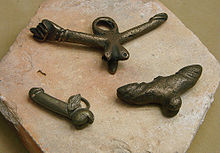Fascinum
Fascinum (plural: Fascina) or Fascinatio originally referred to “inscription” and “bewitching” in Roman antiquity, later the depiction of an erect penis as a means against the evil eye .
etymology
The etymology of the word was already controversial in antiquity: Aulus Gellius quotes Cloatius Verus , who derives it from the Greek βασκανία, which means "slander", but also "bewitchment". Accordingly, βασκάνιον is a remedy against bewitchment. In Sextus Pompeius Festus , Fascinum and Fas are derived from fari ("announce", "speak").
Apotropaic phallus
If one assumes that the derivation from the Greek is correct, the change in meaning of Fascinum from a designation of the evil eye to a means of averting it is not great. This remedy specifically took the form of a mostly grotesquely enlarged erect penis, the
- worn as an amulet,
- was combined with other apotropaic objects (e.g. dwarfs) in so-called Tintinnabula , bells that served as doorbells, or
- painted on or as a bas-relief on houses or carved into the pavement to protect against evil.
Street pavement in Pompeii
City wall stone in Saragossa
Tintinnabulum from Herculaneum
literature
- Matthew W. Dickie: Βασκχάνια, πϱοβασκάνια and πϱοσβασχάνια. In: Glotta, vol. 71, 3./4. H. (1993), pp. 174-177
- Friedmar Kuhnert : Fascinum. In: Paulys Realencyclopadie der classischen Antiquity Science (RE). Volume VI, 2, Stuttgart 1909, Sp. 2009-2014.
Web links
Individual evidence
- ↑ Gellius Noctes Atticae December 16, 2004: item "fascinum" appellatum quasi "bascanum" et "fascinare" eat quasi "bascinare".
- ^ Paulus Diaconus epitome ex Festus 88.16: Fascinum et fas a fando nominantur .




